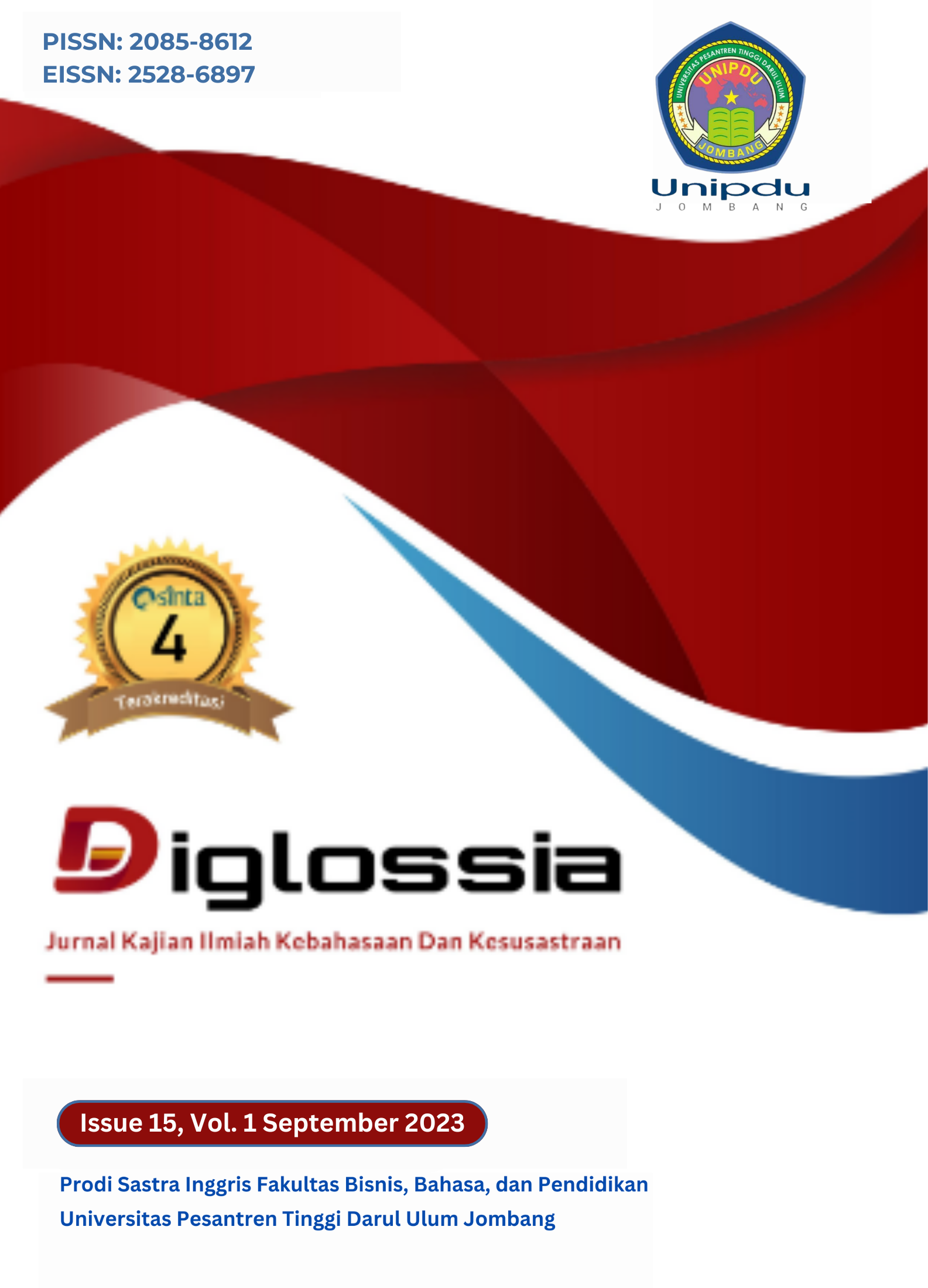Investigating The Use of Illocutionary Acts Performed by Jenna Ortega in Some Interviews
DOI:
https://doi.org/10.26594/diglossia.v15i1.3867Keywords:
jenna ortega, illocutionary act, illocutionary, interviewAbstract
The purpose of this study is to identify the types and the functions of illocutionary acts performed by Jenna Ortega in several of her interviews. The data sources used in this descriptive qualitative research are several videos of Jenna Ortega's interviews in 2022 on YouTube. This study uses the theory of Searle (1969) to determine the types of illocutionary act and Yule's theory (1996) to determine the functions of the illocutionary act performed. The results of this study indicate that there are three types of illocutionary acts performed by Jenna Ortega in some of her interviews, they are: assertive, commissive, and expressive. In this study, it was found that assertive was the most frequently used type of illocutionary act and conveying information as the most frequently appeared function of illocutionary act in some of Jenna Ortega's interviews in 2022.
References
Abuarqoub, I. A. S. (2019). Language barriers to effective communication. Utopia y Praxis Latinoamericana, 24(Extra6), 64–77.
Armistany, P., & Zamzani, Z. (2019). the Functions of Illocutionary Speech Acts Used By Teachers in the Classroom Interactions. LiNGUA: Jurnal Ilmu Bahasa Dan Sastra, 14(1), 187–196. https://doi.org/10.18860/ling.v14i1.6444
Attamimy, H. F., Junining, E., & Khasanah, I. (2020). Speech Act Analyisis of Jacinda Ardern About Covid-19. Elite English and Literature Journal, 7(2), 209. https://doi.org/10.24252/10.24252/elite.v7i2a9
Austin, J. L. (1962). How to Do Things with Words (J. O. Urmson (ed.)). Oxford University Press.
Azmillah, D. (2021). An analysis of illocutionary act in Oliver Henry’s short stories. Universitas Islam Negeri Sunan Ampel Surabaya.
Holmes, J., & Wilson, N. (2017). An Introduction to Sociolinguistics (5th ed.). Routledge. https://doi.org/https://doi.org/10.4324/9781315728438
Kurniati, E. (2017). The Correlation of Students’ Listening Habit in English Conversation with Vocabulary Mastery of the Second Semester Students’ English Education at Teacher Training and Education Faculty at Batanghari University Academic Year 2015/2016. Jurnal Ilmiah Universitas Batanghari Jambi, 17(1), 227–236.
Leavy, P. (2017). Research Design: Quantitative, Qualitative, Mixed Methods, Arts-Based, and Community-Based Participatory Research Approaches. The Guilford Press.
Lubis, P. A. S. (2018). Illocutionary Acts in Alice In Wonderland Movie Script. University of Muhammadiyah Sumatera Utara.
McKay, M., Davis, M., & Fanning, P. (1995). Messages: The Communication Skills Book (2nd ed.). New Harbinger Publications.
Moaveni, H. T. (2014). A Study of Refusal Strategies by American and International Students at an American University [Minnesota State University]. https://cornerstone.lib.mnsu.edu/etds
Mowlana, H. (2013). Communication and Cultural Settings: An Islamic Perspective. In The Global Intercultural Communication Reader (2nd ed.). Routledge.
Nordquist, R. (2018). Illocutionary Force in Speech Theory: Glossary of Grammatical and Rhetorical Terms. ThoughtCo. https://www.thoughtco.com/illocutionary-force-speech-1691147
Oktaviani, A. V. (2018). Illocutionary Acts Performed by Alice in “Alice Through the Looking Glass” Movie Script by Linda Woolverton. Sanata Dharma University.
Rabiah, S. (2012). Language as a tool for communication and cultural reality discloser. Rethinking Multiculturalism: Media in Multicultural Society”, 1–11. http://slubdd.de/katalog?TN_libero_mab216782845
Searle, J. A. (1969). Speech Acts: An Essay in the Philosophy of Language. Cambridge University Press. https://doi.org/https://doi.org/10.1017/CBO9781139173438
Sirbu, A. (2015). The significant of language as a tool of communication. PROQUEST SciTech Journals, XVIII(2), 405–406. https://doi.org/10.21279/1454-864X
Yule, G. (1996). Pragmatics (H. G. Widdowson (ed.). Oxford University Press.
Downloads
Views: 384 | Downloads: 277
Published
How to Cite
Issue
Section
License
Copyright (c) 2023 Diglossia: Jurnal Kajian Ilmiah Kebahasaan dan Kesusastraan

This work is licensed under a Creative Commons Attribution 4.0 International License.
- Authors who submit a manuscript to this journal and accepted for publication, copyright of the article shall be assigned to the authors of the article.
- Copyright encompasses exclusive rights to reproduce and deliver the article in all forms and media, including reprints, photographs, and any other similar reproductions, as well as translations. The reproduction of any part of this journal, its storage and transmission of databases by any forms or media, such as electronic, mechanical copies, photocopies, and recordings will be allowed by Diglossia
- Editorial Board of Diglossia tries to make every effort to ensure that no wrong or misleading data, opinions or statements be published in the journal. The contents of the articles published to Diglossia are sole and exclusive responsibility of their respective authors.
- The copyright form should be filled with respect to article and be signed originally and sent scanned document file (softcopy) and the article to our email, jurnal.diglossia@fbs.unipdu.ac.id or sent it to the Editorial Office in the form of original hard copy and the article in softcopy form on Flash Disc or Compact Disc, to;Diglossia: Jurnal Kajian Ilmiah Kebahasaan dan Kesusastraan
Prodi Sastra Inggris Fakultas Bisnis dan Bahasa
Universitas Pesantren Tinggi Darul Ulum
Kompleks Pondok Pesantren Darul Ulum
Rejoso Peterongan Jombang Jawa Timur 61481

